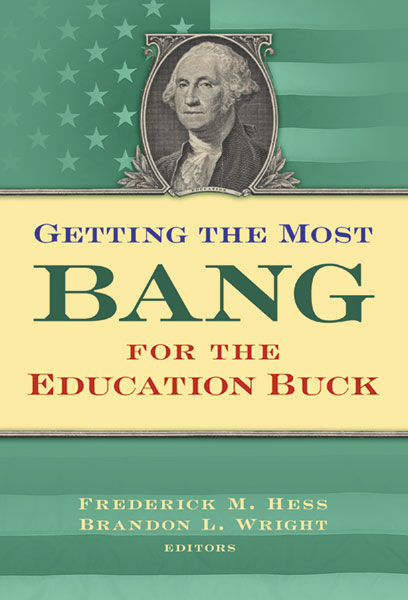Professors: Request an Exam Copy
Print copies available for US orders only. For orders outside the US, see our international distributors.
Edited by: Frederick M. Hess, Brandon L. Wright
Publication Date: September 18, 2020
Pages: 192

How might school funds be spent more effectively in today’s uncertain environment? This up-to-date volume explores a range of ideas to help schools and districts better manage their resources, including: how to rethink staffing and management to get more value for employee compensation; how policymakers might revisit pension arrangements in ways that control costs while putting more teacher compensation in the form of take-home pay; how educators and policymakers can leverage technology as a performance-enhancer and not just a cost-cutting opportunity; and how districts might frame spending options differently in order to more properly assess the needs and preferences of students and families. As American education enters the next decade of challenges, including financial shortfalls due to the COVID-19 pandemic, Getting the Most Bang for the Education Buck will be a valuable guide for how to spend dollars wisely and well.
Book Features:
Frederick M. Hess is the director of education policy studies at the American Enterprise Institute, author of the popular Education Week blog “Rick Hess Straight Up,” and coeditor of Common Core Meets Education Reform and Private Enterprise and Public Education. Brandon L. Wright is the editorial director of the Thomas B. Fordham Institute.
“Lots of books tell educators what’s wrong with the way they spend their resources. This one tells them how to spend their resources right. As budgets decline post-COVID-19, leaders and policymakers need to know how to make the most of limited resources. This book offers practical solutions to real-world problems like outdated staffing models, declining enrollments, and increasing special education costs, along with frameworks for tackling other tough resource-allocation challenges.”
—Carrie Conaway, senior lecturer on education, Harvard Graduate School of Education
“While greater spending on students is always the ideal, a defining feature of public education is resource scarcity. Hess, Wright, and their colleagues provide a research-driven framework for moving beyond the simple question of whether more money is better to the essential question of the coming era: What is the best way to use the limited dollars we have to meet the needs of all students?”
—Celine Coggins, executive director, Grantmakers for Education
“Education leaders often need fresh insights on entrenched struggles. This book serves as a thought-piece that reveals inspiring new perspectives. And with new perspectives come new and unexpected insights on how to deploy resources in ways that improve outcomes for our students.”
—AJ Crabill, former deputy commissioner, Texas Education Agency
“Starting from the well-established premise that money matters for high-quality K-12 schooling, this thought-provoking book explores ways that policymakers and practitioners might think about how to use their valuable resources effectively and efficiently. This is a worthwhile read for those hoping to better understand the financial predicament of school systems today and to improve outcomes for students and schools when resources are tight.”
—Katharine O. Strunk, professor and Erickson Distinguished Chair, Department of Educational Administration, Michigan State University
Contents
Acknowledgments vii
Introduction 1
Brandon L. Wright
PART I: WHERE WE ARE 9
1. American Schools Look to a Challenging Funding Future 11
Matthew Ladner
2. How to Address the Rising Cost of Employee Benefits 19
Chad Aldeman
3. The Relationship Between School Funding and Student Outcomes 35
Adam Tyner
PART II: THE WAY FORWARD 53
4. Schools and Systems That Are Getting More Bang for Their Buck 55
Michael Q. McShane
5. How the “Would You Rather” Test Can Help with School Finance Decisions 69
Marguerite Roza
6. Rethinking School Staffing 89
Bryan Hassel and Emily Ayscue Hassel
PART III: GETTING STARTED 111
7. Bridging the Technological Divide (for Good): How Public Education Leaders Can Successfully Integrate Technology, Without Breaking the Bank 113
Scott Milam, Carrie Stewart, and Katie Morrison-Reed
8. Breaking the Vise of Declining Enrollment 125
Karen Hawley Miles
9. Cost-Effective Special Education: Good for the Budget, Great for Kids 145
Nathan Levenson
Conclusion 161
Frederick M. Hess
About the Contributors 169
Index 173
Professors: Request an Exam Copy
Print copies available for US orders only. For orders outside the US, see our international distributors.